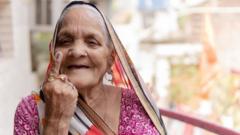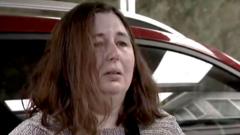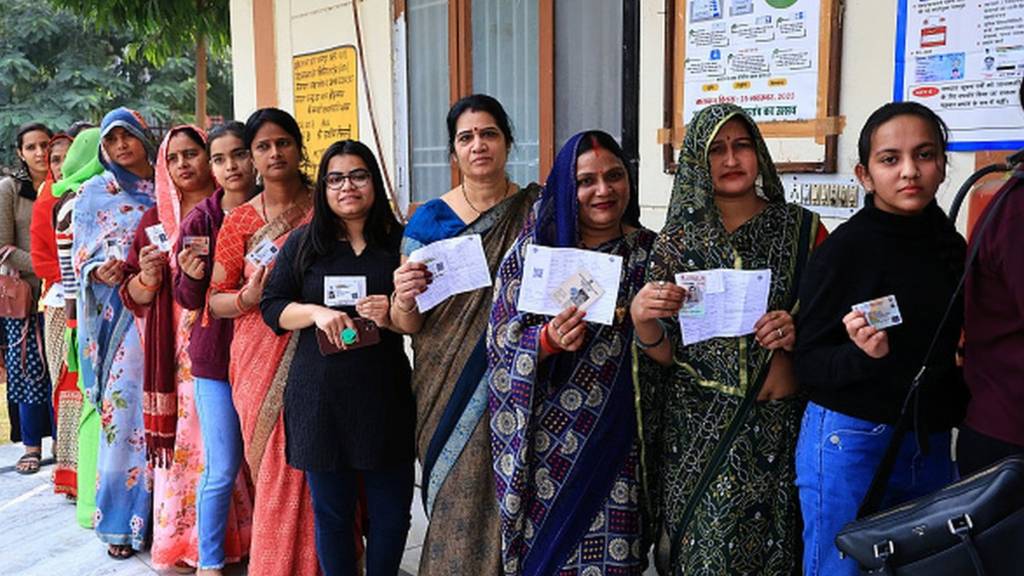
Related Video and Audio
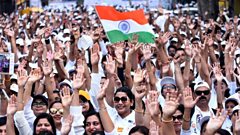
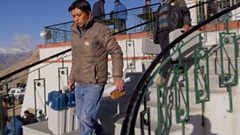

RTL
Got a TV Licence?
You need one to watch live TV on any channel or device, and BBC programmes on iPlayer. It’s the law.
Live Reporting
Produced by Geeta Pandey & Sharanya Hrishikesh
All times stated are UK
-
Watch: Lending a helping hand
A volunteer helps an elderly woman cast her vote at a polling station in the north-eastern state of Sikkim. The state is also holding simultaneous assembly elections along with the Lok Sabha polls.
Video content
Video caption: Watch: A volunteer helps a senior citizen cast her vote -
Poll officials come to elderly and disabled voters
For the first time, the Election Commission is allowing elderly and disabled voters to vote from home.
There are more than 8.2 million voters between 85-99 years and 230,000 centenarians. Over the last few weeks, commission officials have been visiting their homes to collect their ballots.

Copyright: BBC
-
Watch: Voters are queuing up outside polling stations
Soon after polling began, a large number of voters began queuing up outside a polling booth in the West Garo Hills district in the north-eastern state of Meghalaya.
Video content
Video caption: Watch: People queue up outside a polling station in Meghalaya -
Young, first-time voters
India has 18m first-time voters who are between the ages of 18-19, with another 197.4m in the 20-29 age group. Surveys show unemployment is among the top concern for India’s youth.

Copyright: BBC
-
Who are the voters?
More than 51% of the voters, or 497 million, are men. The number of female voters, which has consistently grown over the years, is only slightly lower at 471 million.

Copyright: BBC
-
The major faces

Copyright: BBC
It’s hard to distil elections in a country as large as India to just a few faces – political choices can vary widely from region to region. But still, here’s a brief guide to the key names:
Narendra Modi: The Indian PM is the face of the government and his Bharatiya Janata Party. He’s aiming for a third straight term in power.
Rahul Gandhi: Member of the opposition Congress party, which was once the dominant political force in India. He belongs to India’s most illustrious political family but hasn’t yet won a national election for his party.
Arvind Kejriwal: Delhi’s popular chief minister and leader of the opposition Aam Aadmi Party (AAP) is in jail on corruption charges that he says are made up. The former bureaucrat is a fiery opponent but his supporters fear his imprisonment will hamper the AAP’s campaign.
Amit Shah: India’s home minister, who is also Mr Modi’s closest confidant, is known as an efficient political strategist.
Mamata Banerjee and MK Stalin: The chief ministers of West Bengal and Tamil Nadu states, respectively, are powerful opposition leaders. Neither is standing for the election but their states – with 42 and 39 seats, respectively – are expected to see interesting contests.
Among the many other names you can expect to hear are BJP leader Yogi Adityanath (chief minister of India’s most populous state Uttar Pradesh) and opposition leaders Sharad Pawar, Uddhav Thackeray and Akhilesh Yadav.
-
What are the key dates?
Friday is just the first phase of the election, with 102 seats going to the polls. Here are the other dates you need to look out for:

Copyright: BBC
Results will be announced on 4 June.
-
Watch: Why the Indian election matters for the world
Video content
Video caption: The Indian election matters for the world. Here’s why -
How big are the elections?
When the world’s most populous country goes to polls, the numbers are bound to be huge. There are nearly 969 million eligible voters. To give you an idea of how large that number is, let’s add together the entire populations of some major countries:

Copyright: BBC
Nearly 1.5 million polling booths with 5.5 million electronic voting machines have been set up to cover the length and breadth of the country. The Election Commission has deployed 15 million polling and security staff and trains and 400,000 vehicles will be used to ferry them.
Read more: A really, really big election
-
So what exactly is happening today?

Copyright: Getty Images
Image caption: India’s parliament is made up of the Lok Sabha (lower house) and the Rajya Sabha (upper house). India’s parliament is made up of the Lok Sabha (lower house) and the Rajya Sabha (upper house). The election beginning today is to vote for MPs for the Lok Sabha.
All citizens living in India who are 18 years or older can register to vote (except for those who are barred on grounds of “unsoundness of mind” or criminality). A party or coalition needs to win 272 seats in the 543-member house to form the government.
Prime Minister Narendra Modi, whose Bharatiya Janata Party(BJP) won 303 seats in the last election, is seeking a third consecutive term in power.
He’s being challenged by an opposition alliance – called the Indian National Developmental Inclusive Alliance or INDIA – formed by more than two dozen parties, including the Congress which was the dominant party for the first 60 years of the country’s existence until the resurgence of the BJP in 2014.
-
India is voting
Hello and welcome to the BBC’s live coverage of the first day of voting in India’s general election.
Millions of people will queue up across the country today to cast their votes to choose a new parliament.
But we won’t get to know the results today – this is just the first of seven phases of voting, with 102 out of 543 seats going to the polls. We have to wait until 4 June to find out which party or coalition has crossed the halfway mark – 272 seats – to form the next government.
India’s election process is long, unique and fascinating, and we have all the updates you need to understand what is happening – and a lot of colour from our reporters in the areas voting today.
Stay with us as we bring you all the news from the day.
Latest Post
